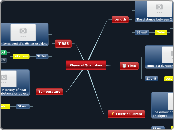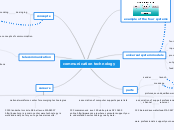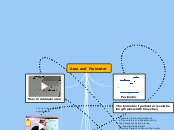Chapter 10: Measurement: Length, Area, and Volume
The purpose of this mind map is to help relate measurement, length, area, and volume to k-6 students with major topics outlined throughout the chapter.
10.3: The Pythagorean Theorem
The Pythagorean Theorem-Leg 1 squared (A^2) multiplied by Leg 2 squared (B^2)equals Hypotenuse squared (C^2)
Converse of the Pythagorean Theorem-Let a triangle have side of length a, b, and c. If a^2+b^2=c^2, then the triangle is a right triangle and the angle opposite of the side of length c is a right angle
The Pythagorean Theorem-Used to find missing side lengths within a right triangle
10.2: Area and Perimeter
Area of a Circle-Pi (3.14) multiplied by radius (R) squared, 3.14 X R^2=A
Circumference of a Circle-Diameter (D) of a circle multiplied by Pi (3.14), D X 3.14=C
Length of a Non-Polygonal Curve-Measure, or estimate, the length of the approximating polygonal curve with vertices on the given curve
Length of a Polygonal Curve-Obtained by summing the length of its sides, S+S+S=L
Area of a Trapezoid- 1/2 of Base 1(B1) added to Base (B2) multiplied by Height (H), 1/2(B1+B2) X H=A
Area of a Triangle-1/2 of the base (B) multiplied by its Height (H), B/2 X H=A
Area of a Parallelogram-Base (B) multiplied by its Height (H), B X H=A
Area of a Rectangle-Length (L) multiplied by its Width (W), L X W=A
Properties of Area
Addition Property-If a region R is dissected into non-overlapping sub-regions, then the sum of the sub-regions is equal to the area of the whole region
The Congruence and Addition Properties of Area-If region R is congruent to region S, then the two regions have the same area
Congruence of Two Regions in the Plane-If R and S are regions in the plane that have the same size and shape, then they are congruent
Circumference-Measurement of the outside of a circle
Lattice Polygons-A polygon formed by joining points of a square array
Unit of Area-Any measurement that tiles a plane. IE: in^2, ft^2
Perimeter-The measurement of the outside of an object. If it is closed by a curve, then the length of the curve is added
Area-The measurement of the inside space within an object
10.4: Volume
Volume-Space that an object occupies
Surface Area- A measurement of the
outermost layer of an object
Volume of a Sphere- 4/3 of Pi (3.14)
multiplied by radius cubed (r^3)
,4/3 X 3.14 X r^3=V
Volume of a Pyramid or Cone-
1/3 of Base (B) multiplied by Height (H),
1/3 X B X H=V
Volume of General Prism or Cylinder-
Base (B) multiplied by Height (H), B X H=V
Volume of a Right Prism or Right Cylinder-
Base (B) multiplied by Height (H), B X H=V
Volume of a Rectangular Box- Length (L)
multiplied by Width (W) multiplied by
Height (H);L X W X H=V
10.5 Surface Area
The Similarity Principle of Measurement-Let Figures I and II be similar. Suppose some length dimension of Figure II of K times the corresponding dimension of Figure I; that is, K is the scale factor. Then:
(i) any length measurement--perimeter, diameter, height, slant height, and so on--of Figure II is K times that of the corresponding length measurement of Figure I
(ii) any area measurement--surface area, area of a base, lateral surface area, and so on--of Figure II is K^2 times that of the corresponding area measurement of figure I and;
(iii) any volume measurement--total volume, capacity, half-fullness, and so on of Figure II is K^3 times the corresponding volume measurement of Figure I
Formulas
Surface Area of a Sphere-4 Multiplied by Pi (3.14) and radius squared (R^2), 4 X 3.14 X R^2=SA
Surface Area of Right Circular Cones-Pi (3.14) multiplied by radius squared (r^2) added to Pi (3.14) multiplied by radius (R) and slant height (S), 3.14 X R^2 + 3.14 X R X S=SA
Surface Area of a Right Regular Pyramid-Base plus 1/2 multiplied by perimeter (P) and slant height (H), B + 1/2 X P X S=SA
Surface Area of a Right Prism or Right Cylinder-Let a right prism or cylinder have Height (H) and bases of area (B), and let P be the perimeter of each base, 2B + B X H=SA
10.1:The Measurement Process
Important Definitions
Measurable Attribute-A property of an object, such as length, area, volume, capacity, temperature, time or weight, which is to be measured
Measurement Process-A sequence of steps that is used in the measuring process
Standardized-To be uniform, or the same, throughout
Unit-Length of measurement
Important Concepts
Conversions between Customary and Metric System-1 meter is about 3.28 ft and 1 ft is about .3048 meters.
Weight-The force exerted on the object by gravity
U.S. Customary Units-inch, foot, year, and mile for length; inches squared, feet squared, yard squared, acre, and miles squared for areal and inches cubed, feet cubed, and yards cubed, quart, and gallon for volume and capacity
U.S. Customary System-Standardized measurement system with well-define units used to communicate size and magnitude
Celsius Temperature Scale-Scale used to measure temperature with 0 degrees as the freezing point of water and 100 degrees as the boiling point
Fahrenheit Temperature Scale-Scale used to measure temperature where 32 degrees is the freezing point of water and 212 degrees is the boiling point
Metric units-Basic unit of length is the meter, with area given in square meters of hectares and volume in cubic meters. Capacity is also given in liters. Mass is given in Grams
The Metric (SI) System-System with units related by powers of 10 described by a prefix system









